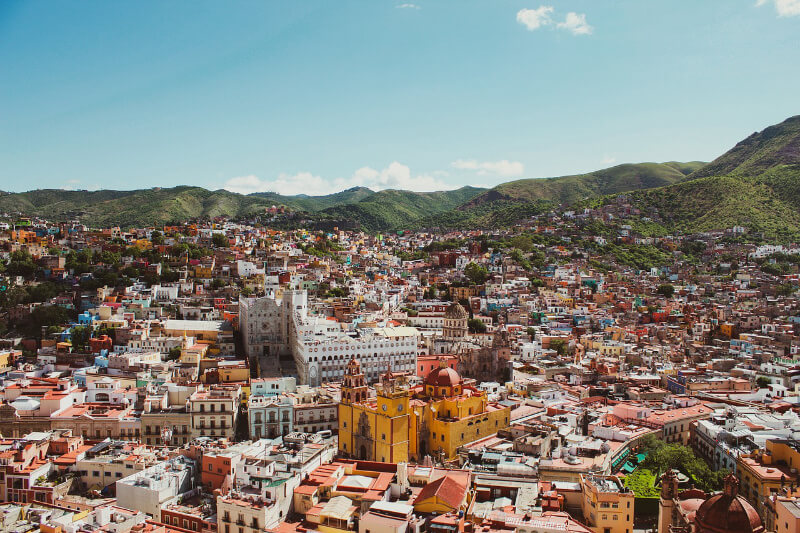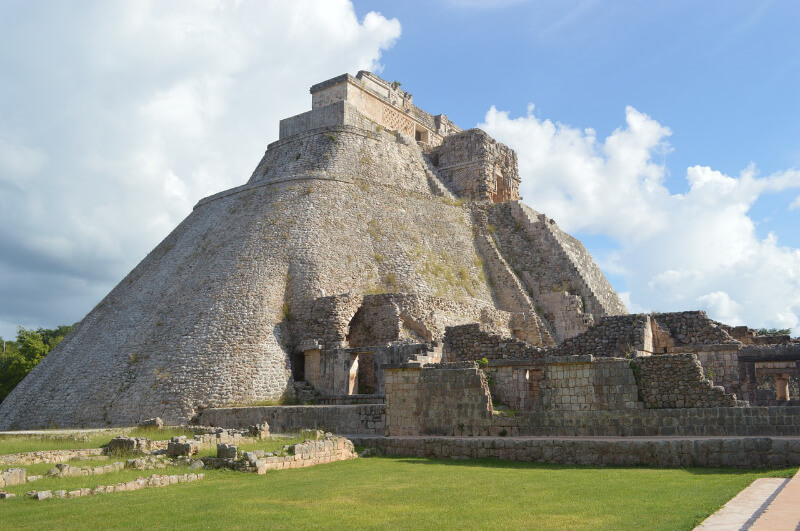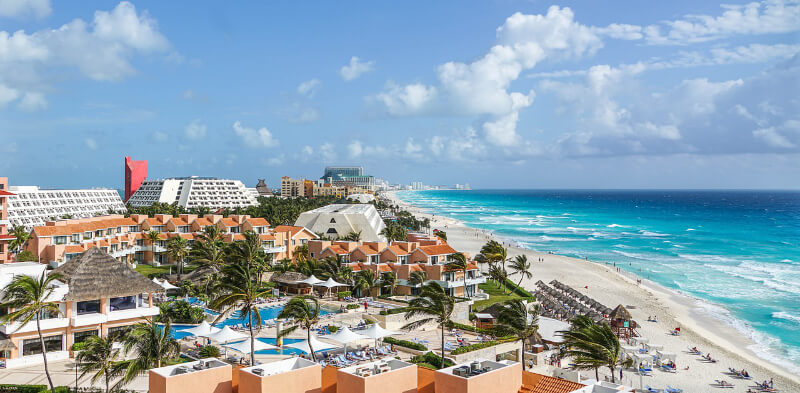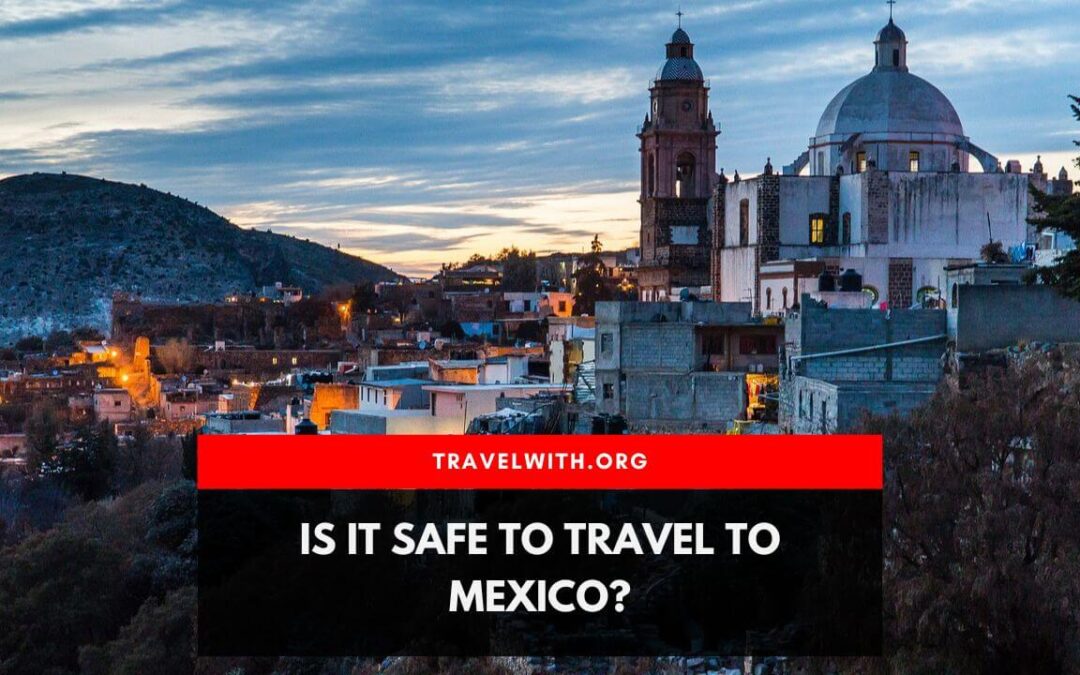It depends. Mexico is a large country, and crime rates can vary from region to region. State Department level 4 “Do Not Travel” warnings still remain in place for Chihuahua and Guanajuato.
Avoiding these areas is the best way to minimize risk. You can fit in better and prevent petty crime by learning some Spanish.
Crime in Mexico
Mexico’s crime rate varies from one region to another. Mexico is such a large country that each area has different crime statistics. In the past, Mexico was warned about as a whole, but now it is divided into different regions so that you can see which areas are safe.
The majority of crime in Mexico comes from violence between cartels. It is a serious problem, but this shouldn’t deter people from visiting Mexico. The majority of violence in Mexico is directed at drug cartels and not tourists. The drug cartels are doing this to avoid drawing the attention of the United States Government and instead concentrate their efforts on fighting amongst themselves.
Mexico’s most popular resorts are safe. They are actually targeted by drug cartels as they are important revenue sources. The drug cartels will spend less time fighting and more time making money if they can keep tourists in their town.
The border areas with the United States are some of the most dangerous places in Mexico for travellers. Tijuana, San Diego and other border cities are among the most dangerous. Ciudad Juarez is one of the Mexican cities with a high crime rate.
It is important to check the latest crime statistics for every city and region before traveling there. It is important to check the most recent data and information, since it can change every day.
In general, murder rates have steadily declined in popular tourist destinations. This is a good sign, as it means tourists aren’t being targeted directly by drug cartels. It is important to note that the overall crime rate of Mexico remains high, but can be reduced by traveling during daylight hours and staying in safe areas of the country.
Learn some Spanish before your trip to Mexico to reduce the risk of crime. You will feel more comfortable and understand the situation better if you can communicate with locals. You will be able to communicate with the locals and get around in an emergency.
Avoiding expensive items, such as a smartphone and a digital camera, will also help you to reduce your risk. Don’t wear flashy clothes or show off jewelry. Dress modestly to blend in and blend with the locals. Avoid large gatherings of people and protests as these can turn violent.

Is san miguel de allende safe?
According to web search results for San Miguel de Allende, the city is safe and has a vibrant cultural scene. According to Numbeo, the crime index is at 50.59 while the safety index is at 49.41. The nightlife in San Miguel de Allende is vibrant and exciting. Solo travelers are welcome and encouraged. This tourist zone is a UNESCO World Heritage Site with many attractions.
You should exercise caution, however, and stay away from bad neighborhoods, or areas around the bus station where minor crimes can occur. Follow the travel advice of your country, and register at the nearest embassy.
Is quintana roo state safe?
Quintana Roo, a Mexican state, is known for its many tourist attractions such as Cancun and Tulum. The state is situated on the Yucatan peninsula, which borders the Caribbean Sea.
The U.S. Department of State advises U.S. citizens to exercise increased caution when traveling to Quintana Roo due to high levels of crime and kidnapping. U.S. Department of State warns U.S. citizens that they should exercise extra caution when visiting Quintana, due to the high level of crime. The Government of Canada advises travellers to exercise caution due to the same reasons 2..
Tourists in Quintana are often victims of petty thefts, pickpocketing and other crimes. These crimes are usually committed in areas that are crowded, like markets, beaches and buses. Keep your documents and valuables in a secure place. Avoid carrying large sums of cash and only use reliable transportation services. Avoid walking at night or alone and be aware of your surroundings.
Quintana Roo is prone to violent crimes such as kidnappings and assaults. Tourists as well as locals may be affected by these crimes, which are usually related to organized crime and drug cartels. Avoid recreational drugs and other illegal activities. Follow the instructions from local authorities and keep an eye on local media to get the latest information. Register with the nearest consulate or embassy of your country, and follow their travel advice.
Quintana Roo offers many adventures and relaxing opportunities. You should be aware of potential dangers, and take the necessary precautions for your safety. This information should be helpful to you. Please let me know if you have other questions.
Drugs in Mexico
The use of drugs is a serious threat to travelers in Mexico. In some areas of Mexico, cartels sell drugs to tourists. This is especially true for those who visit beach resorts. The drugs are usually distributed on the street by locals and homeless people (Malkin, NY Times). Drug use can be a contributing factor to homicide in some cases.
Possession of heroin, cocaine, or marijuana in Mexico can lead to a prison sentence of up 25 years. Some Mexican cities and towns may also have other illegal substances such as methamphetamine. They can cause nausea, hallucinations and other health issues. Travellers with medical conditions are at risk. It is important that travellers carry their own medical supplies and seek immediate medical attention if any side effects occur.
Some Mexican towns and cities cater to drug tourists. Some pharmacies sell medications that look safe, but contain deadly fentanyl. Travelers should be cautious when purchasing medication in Mexico from street vendors or online pharmacies.
Gunmen have been involved in many drug-related incidents, including attacks on resorts and restaurants at Cancun and Playa del Carmen. The robbers have also targeted tourists on cruise ships, and clubs and bars throughout the region. These events have left many tourists traumatized, and others have decided not to travel in the region.
Drug trafficking is on the rise in Mexico as more locals become involved. The violence against foreigners has increased. There are also more people in the country who have drug addictions. Others are asymptomatic but are at risk of developing an opioid use disorder, which can lead overdoses or death.
The OUD problem in Mexico is not just a concern for those who live there. It also has an impact on Americans, as many people with OUD are moving to Tijuana to find cheaper and easier drugs.
Researchers conducted a study to examine the relationship between migration patterns and drug abuse among Mexican transnationals. Researchers found that migrants are more likely than non-migrators to have used illicit drugs, and to have consumed more drugs. This could be due to the social isolation that comes with spending so much time away from family, or to the inability to establish roots in the U.S. These findings suggest that those living near the border are at a higher risk of using drugs.
What parts of mexico are not safe?
Travelers should avoid certain parts of Mexico due to the high level of crime and violence. This is often linked to organized crime and drug cartels. According to web searches, the most dangerous parts of Mexico include:
- Colima State, where homicide rates are 109.38 per 100 000 residents
- Guerrero State, where security is in a precarious situation following the damage caused by Hurricane Otis
- Michoacan State, where cartel clashes are common
- Sinaloa, where the Sinaloa Cartel controls the city of Culiacan
- Tamaulipas, a state where kidnappings of children and carjackings occur frequently
- Zacatecas, where violence has increased over the past few years

The U.S. Department of State3 or Government of Canada4 has issued an advisory of Level “Reconsider Travel”, or Level 4 “Do Not Travel”. Avoid these areas, or use extreme caution when you travel there.
In Mexico City, there are certain neighborhoods and roads that have a high rate of crime, including Tepito. Doctores. Guerrero. Iztapalapa. Avoid traveling alone, especially after dark. Use reputable transport services and obey local authorities.
There are many beautiful and safe places to visit in Mexico, including Campeche, Yucatan, and the colonial towns and beaches. More information can be found on travel advisory websites. This information should help you to plan your trip. Please let me know if you have any questions.
Express Kidnapping
Travelers should be aware that the Mexican government is making efforts to reduce the kidnapping rate. Consult websites such as those of the U.S. State Department or SOS International and use the country-specific travel advice to learn more.
Criminals who pose as taxi drivers steal the belongings of travellers, including their credit and debit cards. They then withdraw cash at ATMs. The thieves usually demand a small ransom in order to free the hostage. This type of express abduction occurs in large urban areas, and can happen at hotels, taxis, public buses and private vehicles.
A longer-term kidnapping is also common in Mexico, when criminals keep a victim captive to gain financial benefit. The crime is usually linked to drug trafficking and can happen anywhere, no matter where you are or what your social status is.
Travellers should research their destinations before making any reservations or booking any tours. Stay up to date with local news, and avoid any areas under siege from violent gangs or drug cartels.
Take precautions and keep moving at all times if you have to travel in an area that the US State Department is highly cautious about. Avoid beaches, open areas and large crowds. Dress conservatively if you have to attend a public gathering. Avoid carrying valuables.
Traveling in Mexico requires that you also be aware of your personal safety, since the country is experiencing an increase in violence against women and sexual assault. Women should avoid showing affection in public and travel with a friend. LGBT+ people are at a higher risk of violence and discrimination. This is especially true in rural areas.
Travelers should carry travel insurance that covers cancellation of a trip, medical costs and evacuation in the event of an emergency. Travelers should also bring medication for allergies, colds, and other health issues, since many drugs are either not available or difficult to get in Mexico. Consult your travel insurance provider if you have dual citizenship between Canada and Mexico. Your coverage terms may be different. You should also carry proof of citizenship at all times, in case you have to cancel or interrupt your trip. Travellers should also avoid drinking tap-water or accepting food from strangers as it can increase their risk of infection and disease.
Are tourist areas in Mexico safe?
Mexico is a popular destination for travelers, featuring charming towns, ancient ruins, and picturesque beaches. However, there are also high levels of crime, particularly violent crime, such as homicides, kidnappings, carjacking and assaults, in some parts of the country. These crimes are often related to drug cartels and organized crime, and may affect tourists as well as locals.
Some of the safest cities in Mexico are Merida, Tulum, Playa del Carmen, Puerto Vallarta, and Cancun. These cities are located in the Yucatan Peninsula or along the Pacific coast, and are known for their beautiful scenery, vibrant nightlife, and cultural attractions. They are also relatively uninvolved in cartel conflicts and have low rates of violent crime directed at visitors.
However, some areas of Mexico are considered very dangerous and should be avoided by travelers. These include Guerrero State, where the security situation is precarious following damage by Hurricane Otis, and several states where clashes between cartels or gangs are common, such as Chihuahua, Colima, Coahuila, Durango, Michoacan, Nayarit, Nuevo Leon, Sinaloa, Sonora, Tamaulipas, and Zacatecas. There are also specific neighborhoods or roads in other cities that are known for high crime rates, such as Tepito, Doctores, Guerrero, and Iztapalapa in Mexico City.
Therefore, if you are planning to travel to Mexico, you should exercise a high degree of caution and take necessary precautions to ensure your safety, such as:
- avoid traveling alone or after dark
- monitor local media for the latest updates on the situation
- follow the instructions of local authorities
- avoid recreational drugs and illegal activities
- keep your valuables and documents in a safe place
- use reputable transportation services and avoid hitchhiking
- register with the nearest embassy or consulate
What is Mexico travel advisory for US citizens?
The U.S. Department of State issued a travel warning for Mexico. It advised U.S. citizens that they should exercise greater caution in Mexico due to the high level of crime. There are also different levels of risk for each state and region in Mexico. These range from “do NOT travel” to “exercise usual precautions”. Among the factors that influence the level of risk are the presence of organized crime, drug cartels and natural disasters.
Campeche and Yucatan are two of the most safest places in Mexico for U.S. residents. You can take normal precautions. These are the states located on the Yucatan Peninsula. They are famous for their Mayan ruins and colonial towns.
You should avoid traveling to these states: Colima (Mexico), Guerrero (Guerro), Michoacan (Michoacan), Sinaloa (1 Sinaloa), Tamaulipas (2 Tamaulipas), and Zacatecas (3 Zacatecas). The states of Colima, Guerrero, Michoacan and Sinaloa are the most dangerous for U.S. citizens.
You should always follow the advice of the travel advisor when you travel to Mexico.
- Monitor local media for updates
- Follow the instructions given by local authorities
- Avoid traveling alone after dark or at night
- Avoid hitchhiking and use reliable transportation services
- Register with the nearest U.S. Embassy or Consulate
The travel advisor website has more information.
What is Mexico travel advisory for Canadian citizens?
The Government of Canada has advised travelers to Mexico, based on the results of web searches, to exercise caution because of the high level of criminal activity. The advisory specifies different levels of risk for different states and areas in Mexico. These range from “avoid travel” to “exercise usual precautions”. Among the factors that influence the level of risk are the presence of organized crime, drug cartels and violence.
The Yucatan Peninsula is home to the Campeche state and Yucatan state, which are both safe for Canadians. You can take normal precautions in these areas. These are the states located on the Yucatan Peninsula. They are famous for their Mayan Ruins, colonial Cities, and beaches.
There are also specific neighborhoods or roads in other cities that are known for high crime rates, such as Tepito, Doctores, Guerrero, and Iztapalapa in Mexico City. Other cities and neighborhoods with high crime rates include Tepito in Mexico City, Doctores in Guerrero or Iztapalapa.
You should always follow the advice of the travel advisor when you travel to Mexico.
- Monitor local media for updates
- Follow the instructions given by local authorities
- Avoid traveling alone after dark or at night
- Avoid hitchhiking and use reliable transportation services
- Register with the nearest Canadian Embassy or Consulate
The travel advisor website has more information.

What are some popular tourist attractions in Mexico?
Mexico has a diverse and rich culture, history and natural environment. Mexico has many tourist attractions that are popular and cater to different tastes and interests. Here are the top places to visit in Mexico.
- Cancun & the Mayan Riviera – This stunning stretch of coastline is located on the Gulf of Mexico. It features white sandy beaches, turquoise water, coral reefs and tropical fish. Nearby ancient Mayan ruins such as Chichen Itza or Tulum can be explored.
- Puerto Vallarta This charming coastal city is located on the Pacific Ocean. You can enjoy the Mexican cuisine and culture in this beautiful city. The colonial architecture is also worth a visit, as are the Malecon boardwalk and whale-watching excursions.
- Cabo S. Lucas and Los Cabos Corridor This popular resort is located on the southernmost tip of the Baja California Peninsula. You can enjoy luxury hotels, golf, and nightlife. The famous El Arco rock is also nearby. You can go snorkeling or diving and see the desert and mountains.
- Copper Canyon: You can also take a scenic train ride through the canyon, hike, bike, or horseback ride, and learn about the indigenous Raramuri people. Take a scenic train ride to the canyon. You can also hike, bike or ride a horseback. Learn about the Raramuri native people.
- Mexico City Historic Center: The heart of Mexico City, you will find the most impressive monuments and buildings that represent the history and culture of the country. The main square is the Zocalo. You can also see the Metropolitan Cathedral – the largest cathedral in Latin America – and the National Palace where you can find the murals of Diego Rivera.
- Chichen Itza is located on the Yucatan peninsula and is one of Mexico’s most impressive Mayan sites. The ancient Maya civilization is reflected in the magnificent pyramids, temples and sculptures. The serpent shadow, which appears on the Pyramid of Kukulcan at the equinoxes, is also a fascinating phenomenon.
- Guanajuato is a charming and colorful colonial town in the highlands of central Mexico. You can see the Spanish influence and its rich history of silver mining. Explore the narrow streets, churches, plazas and museums. You can also visit the Mummy Museum to see the preserved bodies of former residents.
- Cozumel : A beautiful island located off the coast Yucatan Peninsula where you can enjoy the coral reefs and marine life. Visit the Chankanaab National Park to see the lagoons, dolphins and botanical gardens. You can also see the Mayan Ruins at the San Gervasio Archaeological Site.

